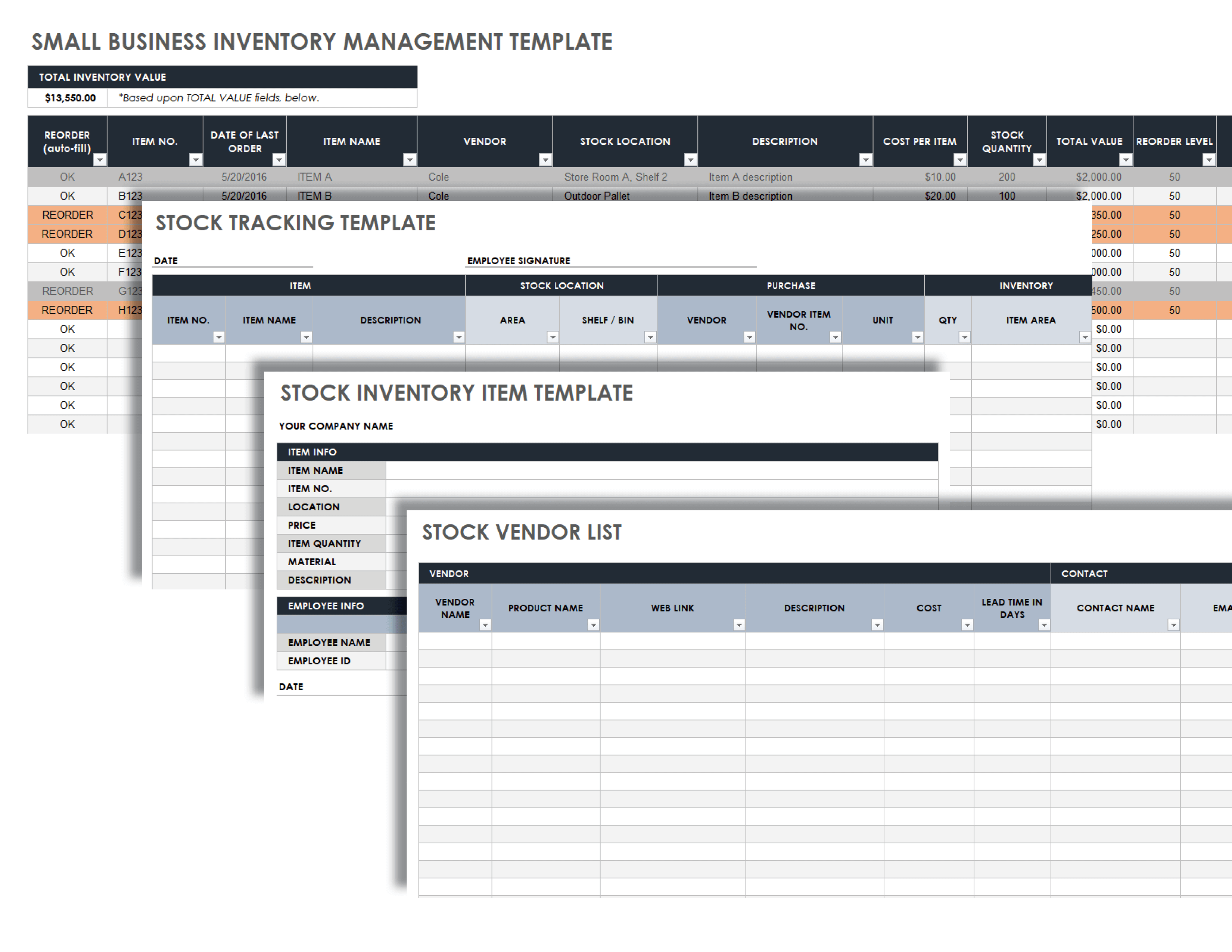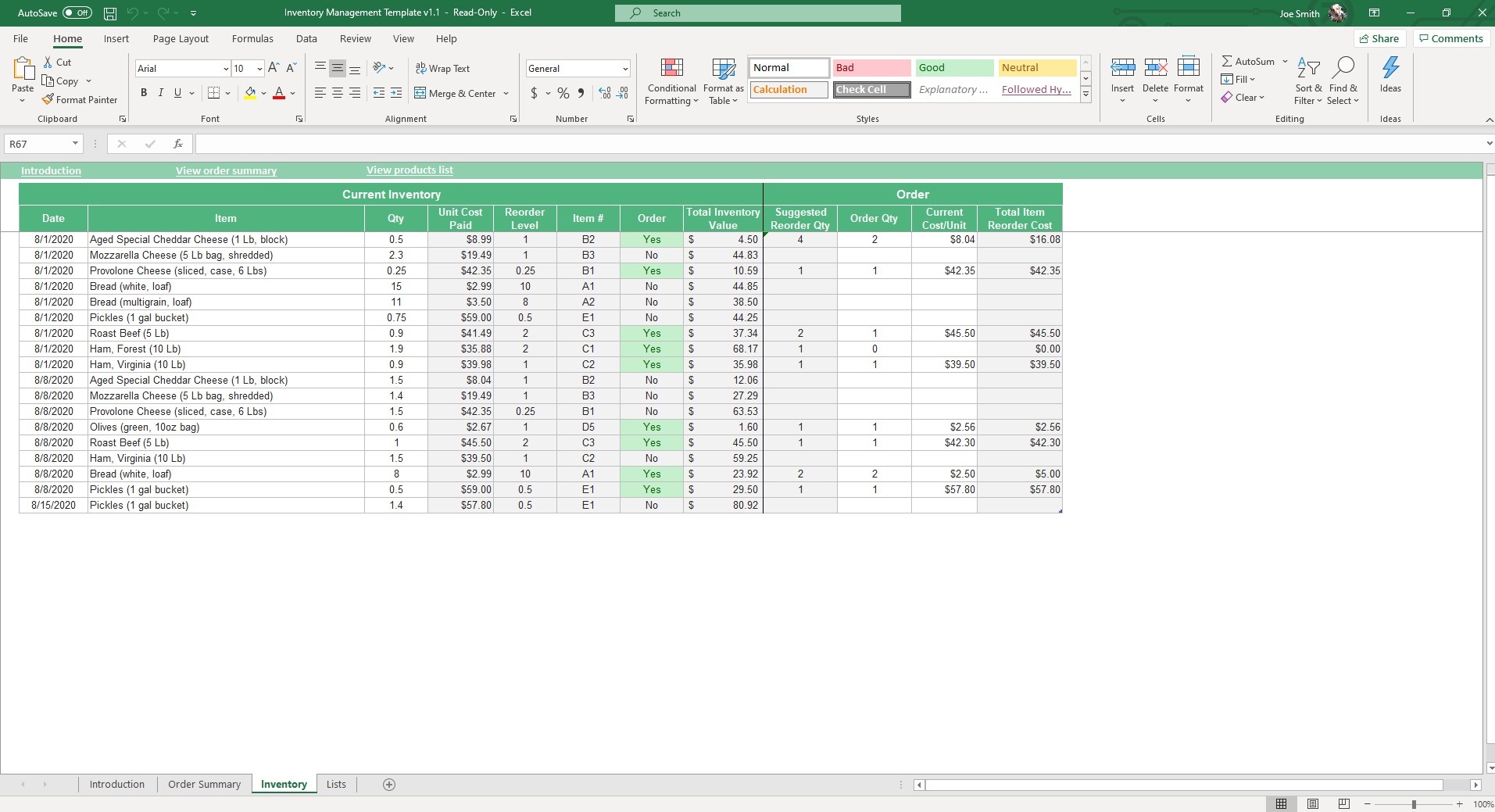Embark on a journey into the realm of small business inventory management excel, where efficiency and organization intertwine. This comprehensive guide unravels the intricacies of inventory management, empowering you with the knowledge and tools to streamline your operations and elevate your business to new heights.
Discover the fundamentals of inventory management, delve into the advantages of utilizing Excel, and master the art of creating a customized Excel inventory management template. Explore advanced Excel techniques and uncover the possibilities of integrating Excel with other business systems.
Prepare to unlock the full potential of your inventory management and witness the transformative impact on your business.
Inventory Management Fundamentals for Small Businesses
Inventory management is crucial for small businesses as it helps optimize stock levels, minimize costs, and improve customer satisfaction. It involves tracking, forecasting, and controlling the flow of goods from purchase to sale.
Inventory Management Techniques
- First-In, First-Out (FIFO):Assumes that the oldest inventory is sold first, resulting in higher cost of goods sold (COGS) during inflationary periods.
- Last-In, First-Out (LIFO):Assumes that the most recently purchased inventory is sold first, leading to lower COGS during inflationary periods.
- Weighted Average Cost:Calculates the average cost of goods sold based on the total cost of all inventory on hand, regardless of when it was purchased.
- Just-in-Time (JIT):Aims to minimize inventory levels by receiving goods only when they are needed for production or sale.
Importance of Inventory Tracking and Forecasting
Inventory tracking involves monitoring inventory levels in real-time to prevent stockouts and overstocking. Inventory forecasting predicts future demand based on historical data, market trends, and other factors. This helps businesses plan for future inventory needs and avoid costly shortages or surpluses.
Benefits of Using Excel for Inventory Management
Excel is a powerful tool that can be used to streamline inventory management processes for small businesses. It offers a range of features that make it an ideal solution for tracking inventory levels, managing orders, and generating reports.
One of the main advantages of using Excel for inventory management is its flexibility. It can be customized to meet the specific needs of any business, regardless of its size or industry. Businesses can create custom templates that include all of the necessary information, such as product descriptions, quantities, and prices.
Excel also makes it easy to track inventory levels in real time. Businesses can use the built-in formulas to automatically calculate the total value of inventory, as well as the quantity of each item on hand. This information can be used to make informed decisions about ordering and restocking.
Managing Orders
Excel can also be used to manage orders. Businesses can create a database of customers and their orders, and then use Excel to track the status of each order. This information can be used to ensure that orders are processed and shipped on time.
Generating Reports
Excel is a powerful reporting tool. Businesses can use it to generate a variety of reports, such as inventory reports, sales reports, and profit and loss statements. These reports can be used to track the performance of the business and make informed decisions about future operations.
Creating an Excel Inventory Management Template

Creating an Excel inventory management template is a simple yet effective way to track your inventory. Here’s a step-by-step guide to help you get started:
Setting Up Columns for Product Information
Start by setting up columns for essential product information. These columns should include:
- Product ID: A unique identifier for each product.
- Product Name: The name or description of the product.
- Category: The category or type of product.
- Supplier: The supplier or vendor from whom the product is purchased.
- Unit Price: The cost of each unit of the product.
Tracking Quantities and Other Data
Next, add columns to track quantities and other relevant data:
- Quantity on Hand: The current number of units in stock.
- Quantity Ordered: The number of units currently on order from suppliers.
- Quantity Sold: The number of units sold during a specified period.
- Reorder Point: The minimum quantity at which a reorder should be triggered.
Using Formulas and Functions
Excel’s formulas and functions can automate calculations and generate reports. For example, you can use the SUM function to calculate the total quantity on hand or the AVERAGE function to find the average unit price.
You can also use conditional formatting to highlight cells that meet certain criteria, such as products that are below the reorder point.
Customizing Excel for Specific Business Needs

Excel offers extensive customization options to adapt to the unique requirements of different businesses. By tailoring Excel to your specific needs, you can streamline inventory management processes and gain insights that drive better decision-making.
Here are several ways to customize Excel for inventory management:
Custom Fields
Create custom fields to capture data specific to your business, such as product dimensions, supplier information, or reorder points. This allows you to track and manage inventory attributes that are essential for your operations.
Drop-Down Menus
Add drop-down menus to simplify data entry and ensure consistency. For example, create drop-down lists for product categories, suppliers, or units of measure. This helps prevent errors and speeds up the inventory management process.
Macros
Automate repetitive tasks using macros. Macros can be created to perform actions such as adding new products, updating inventory levels, or generating reports. This saves time and reduces the risk of errors.
Dashboards and Visualizations
Excel’s built-in tools allow you to create dashboards and visualizations that provide a comprehensive overview of your inventory data. Use charts, graphs, and pivot tables to analyze trends, identify patterns, and make informed decisions.
Integrating Excel with Other Business Systems

Excel’s versatility extends beyond its standalone capabilities. By integrating it with other business systems, such as accounting software or CRM systems, businesses can unlock new levels of efficiency and data management.
Benefits of Data Sharing and Synchronization
Integrating Excel with other systems enables seamless data sharing and synchronization. This eliminates manual data entry errors and ensures consistency across different platforms. Real-time updates in one system are automatically reflected in others, providing a single source of truth for inventory data.
Excel as a Central Hub for Inventory Management
Excel can serve as a central hub for inventory management, connecting disparate systems and consolidating data from various sources. This allows businesses to manage inventory levels, track stock movements, and generate reports from a single platform.
- Example:A small business using QuickBooks for accounting and Salesforce for CRM can integrate Excel with both systems. This allows them to automatically update inventory levels in QuickBooks based on sales orders in Salesforce, ensuring accurate stock counts and avoiding overselling.
Advanced Excel Techniques for Inventory Management: Small Business Inventory Management Excel
As your business grows and inventory management becomes more complex, you may need to explore advanced Excel techniques to enhance your capabilities. These techniques can help you analyze inventory data more efficiently, identify trends, and make better decisions.
Pivot Tables
Pivot tables are a powerful tool for summarizing and analyzing large datasets. They allow you to create interactive tables that can be filtered and sorted to reveal patterns and trends in your inventory data.
For example, you could create a pivot table to summarize inventory levels by product category, location, or supplier. This can help you identify which products are selling well, where your inventory is located, and which suppliers are most reliable.
Conditional Formatting
Conditional formatting allows you to apply different colors, fonts, or icons to cells based on specific criteria. This can help you quickly identify important information or trends in your inventory data.
For example, you could use conditional formatting to highlight inventory items that are low in stock, have high turnover rates, or are approaching their expiration dates.
Data Validation, Small business inventory management excel
Data validation allows you to restrict the type of data that can be entered into specific cells. This can help you ensure that your inventory data is accurate and consistent.
For example, you could use data validation to ensure that inventory quantities are always positive numbers or that product codes are entered in a specific format.
Questions Often Asked
What are the key benefits of using Excel for inventory management?
Excel offers numerous advantages, including ease of use, flexibility, cost-effectiveness, and the ability to automate calculations and generate reports.
How do I create a basic Excel inventory management template?
Start by creating columns for product information, quantities, and other relevant data. Use formulas and functions to automate calculations and generate reports.
Can I customize Excel to meet my specific business needs?
Yes, Excel allows for customization by adding custom fields, creating drop-down menus, and using macros. You can also leverage Excel’s built-in tools to create dashboards and visualizations.